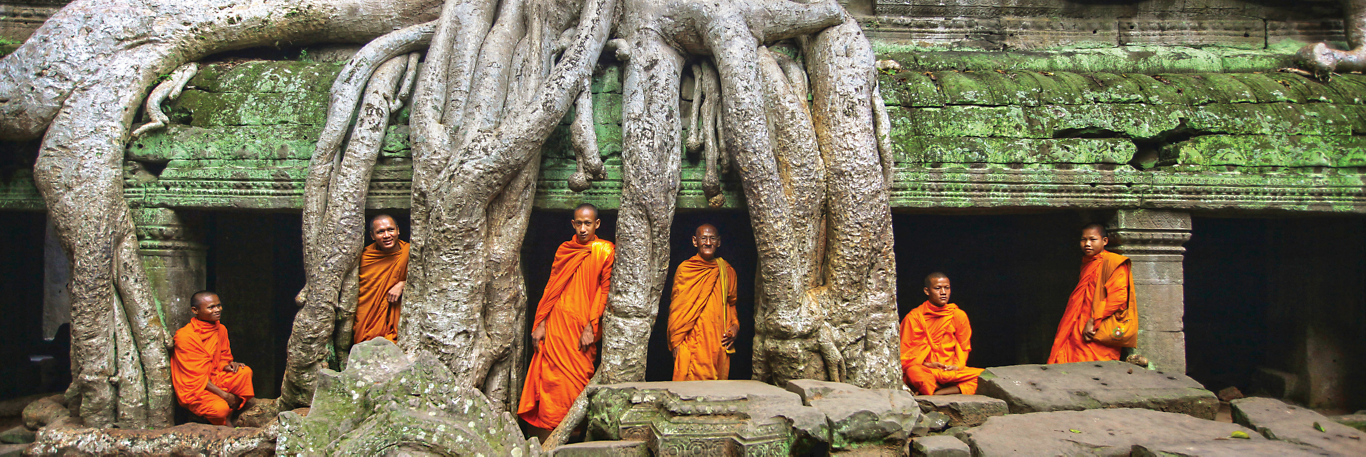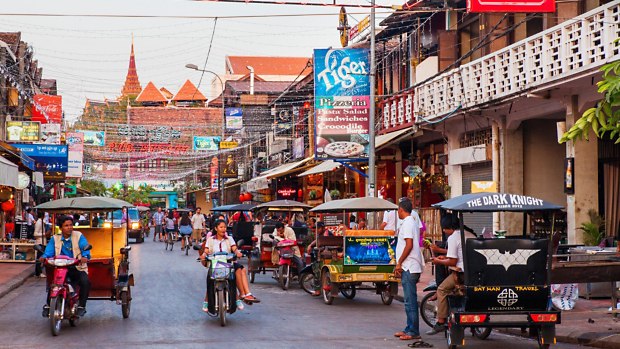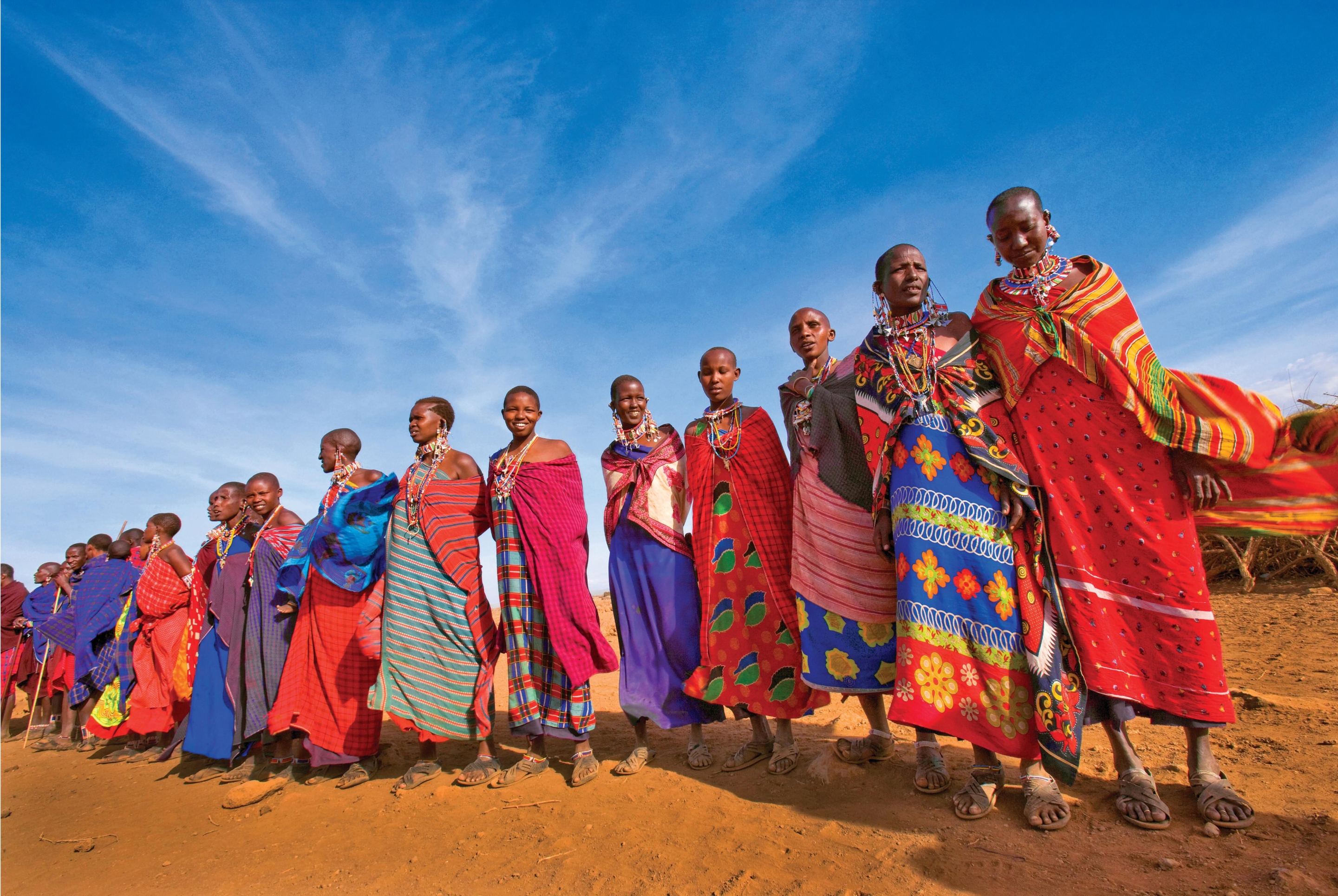You’re receiving this message because your web browser
is no longer supported
We recommend upgrading your browser—simply click the button below and follow the instructions that will appear. Updating will allow you to accept Terms and Conditions, make online payments, read our itineraries, and view Dates and Prices.
To get the best experience on our website, please consider using:
- Chrome
- Microsoft Edge
- Firefox
- Safari (for Mac or iPad Devices)

cambodia
Overseas Adventure Travel, the leader in personalized small group adventures, has been helping change lives through travel since 1978. Our Cambodian Small Group Adventure will take your small group into the heart of a destination to venture where the big tour groups can’t. No matter which adventure you choose, O.A.T. always offers:
- The freedom to personalize your experience, with options to arrive early, add pre- or post-trip extensions, stopover in popular cities, and more.
- Small group of no more than 16 travelers, allowing us to take you off the beaten path and immerse you in local culture.
- Adventures tailored to the solo traveler, with FREE Single Supplements and 23,000 single spaces being offered in 2024.
- Expert Trip Experience Leaders, residents of the region you visit who will share their insights and bring your destination to life.
When you set out on an O.A.T. Cambodia adventure, there are endless travel experiences waiting for you. Studying the intricate bas-relief carvings of the ancient pyramid temple of Angkor Wat. Learning about the dark history of the Khmer Rouge from a local who survived the genocide of the Killing Fields. Meeting the residents of a remote “floating village” on Tonle Sap Lake. Discover all of this and much more when you journey to Cambodia with O.A.T.
Compare Our Adventures
Click 'Select to Compare' to see a side-by-side comparison of up to adventures below—including
activity level, pricing, traveler excellence rating, trip highlights, and more

Spend 6 days in Cambodia on
Ancient Kingdoms: Thailand, Laos, Cambodia & Vietnam
O.A.T. Adventure by Land
Thailand: Bangkok | Laos: Luang Prabang, Mekong River Cruise, Vientiane | Cambodia: Phnom Penh, Angkor Wat | Vietnam: Ho Chi Minh City (Saigon)
Spend 5 days in Cambodia on our
Post-trip Extension
Cambodia: Angkor Wat & the Legacy of the Ancient Khmer Empire
Cambodia: Angkor Wat & the Legacy of the Ancient Khmer Empire

Compare Adventures
Add Adventure
including international airfare
per day
*You must reserve the main trip to participate on this extension.
**This information is not currently available for this trip. Please check back soon.
You may compare up to Adventures at a time.
Would you like to compare your current selected trips?
Yes, View Adventure ComparisonCambodia: Month-By-Month
There are pros and cons to visiting a destination during any time of the year. Find out what you can expect during your ideal travel time, from weather and climate, to holidays, festivals, and more.
Cambodia in January-February
January and February offer a respite from the humidity Cambodia is known for—this is the driest time of year. Sunning on the southern beaches is particularly comfortable as temperatures have not yet risen to their highs.
Peak tourism season began ramping up in November with lower temperatures and humidity. Popular destinations such as Angkor Wat will be crowded. Bustling Phnom Penh—year-around an energetic hub of commerce and culture—will be even more crowded with tourists from around the world.
With high water levels, this is the best time to visit Tonle Sap Lake and the Mekong River. Even lower temperatures near bodies of water means sailing by paddle boat or river cruise lend to a more adventurous experience.
Holidays & Events
- February: Chinese and Vietnamese New Year
Must See
Chinese and Vietnamese New Year is arguably the largest celebration in Eastern Asia with ornate parades, music, and breathtaking fireworks displays.
Cambodia in March-April
Temperatures in March are quickly on the rise, and by April they have hit average highs of 93 degrees. Tourism season starts to wane, so exploring Phnom Penh and other urban areas will be a more authentic and less expensive experience. Navigating the city's frenetic streets, you’ll see more traditional food, less souvenir stands, and less crowding. Take advantage of the value of your tourism dollars and delve into a city which at this time becomes quintessentially Cambodian.
Holidays & Events
- April 14: Khmer New Year
Must See
Khmer New Year is celebrated both in Cambodia and throughout the world among the Cambodian diaspora. With ornate traditional costumes, games, and even street parties and gatherings, this is one of the most exciting times for the Khmer culture.
Cambodia in May-June
The humidity of the previous couple of months breaks in May and June with the wet season's heavy downpours. Robust excursions into the Cambodian countryside are more manageable with lower temperatures—on clear days, the wide expanses of bright green rice paddies under stunning blue skies come together like a beautiful painting.
As peak season has ended, this is a great time to explore the breathtaking scale of Angkor Wat and Banteay Srei's ornate sculptures honoring women. These popular sites, as well as the urban areas, are not crowded with tourists.
Holidays & Events
- May: The Royal Ploughing Ceremony
Must See
The Royal Ploughing Ceremony is celebrated all over Southeast Asia, marking the beginning of the rice-growing season. Traditionally, the country's monarch will drive a plow in ceremonial land, followed by priests planting seeds to ensure a bountiful harvest.
Cambodia in July-September
Monsoons cover southwestern Cambodia in quick bursts of torrential rains. Road closures are common as many are simple mud paths, and mosquitoes are more prevalent.
The countryside is particularly striking, with the previous season's steady rains fostering lush green vegetation. The thunderstorms are famous at this time of year, especially in rural Cambodia. The rivers are also at their peak—Tonle Sap Lake begins to fill up again, making for great cruising opportunities.
As this is low season, prices for goods and tours are lower.
Holidays & Events
- Late September-early October: Pchum Ben is a 15-day festival in which families honor deceased relatives, sometimes from up to seven generations past. Food offerings for Buddhist monks and ancestor spirits are made in hopes of generating merit for passed relatives.
Must See
Rains have refreshed the waters around Angkor Wat, making the temple's reflection—a site in itself—clear and stunning.
Cambodia in October-December
From October to the end of the year, Cambodia enters a calm and comfortable season. The rains have subsided, and temperatures stay within a range of 70-80 degrees. Blue skies dotted with clouds make for incredible views in the countryside. This is the time for hiking the rugged northern highlights and going off the beaten path.
Many people spend Christmas in Cambodia because of cooler temperatures and exotic adventures. Peak tourism season begins ramping up in November, so crowds will slowly build in popular destinations such as Phnom Penh and Angkor Wat.
Holidays & Events
- November: Bon Om Touk, otherwise known as the Water Festival, marks the end of the rainy season. People in Cambodia and diaspora communities across the world celebrate with boat races and water games. Steaming street food, water fights, and joviality fill the streets of cities and towns. The festival marks the reversal of the Tonle Sap River's flow, draining into the Mekong River.
Must See
Tonle Sap Lake is at its highest level. With the flow reversal of the Tonle Sap River from the lake, the water levels of the Mekong River increase slowly. Fishing in the Tonle Sap is illegal at this time to avoid disruption of the breeding season. This means boating on the lake is a more pleasant and serene experience.
Average Monthly Temperatures
High Temp Low Temp
Cambodia Interactive Map
Click on map markers below to view information about top Cambodia experiences
Click here to zoom in and out of this map
*Destinations shown on this map are approximations of exact locations
Tuol Sleng Prison Museum/Killing Fields of Choeung Ek

The Khmer Rouge era may have lasted only four years, but it was without question the deadliest time in Cambodia’s history. Paranoia about suspected “enemies” led to the capture, torture, and murder of nearly one in five Cambodians alive at the time. (Starvation claimed so many more, that nearly 25% of the population did not survive the regime.) In Phnom Penh, a high school became the most notorious of execution centers, Security Prison 21. (Now, it serves as the Tuol Sleng Genocide Museum.) Citizens were brought here, photographed, made recount their biographies, stripped, and then imprisoned and tortured until they named other friends or loved ones who should also be jailed. In this one site, 20,000 prisoners were executed (an average of one every 90 minutes for the entire reign of the Khmer Rouge). “Killing fields,” scenes of mass execution, were common all across the country, and so far, 20,000 mass burial graves have been uncovered. The legacy of that time is still profound; as everyone in their mid-forties and older lived through the era, its lessons will not soon be forgotten.
Experience Tuol Song Prison Museum and the Killing Fields with O.A.T. on:
Siem Reap

As the leaping-off point for visits to the temples of Angkor Wat, Siem Reap could be just a pass-through town, not a destination in itself. But Siem Reap has its own charms and offerings for those who would pause here. There are evidences of eras past in Old French Quarter, where tuk-tuks roll by colonnaded buildings with elegant balconies. In the Psah Chas (Old Market) at the heart of the city, navigating the jumble of lanes might seem intimidating at first, but it offers a true taste of Cambodian life, with vendors displaying everything from silken fabrics to fresh slabs of bacon. At night, closer to the river, the traditional Angkor Night Market comes alive as a glittering beehive of activity. But more contemporary delights are on offer as well: Siem Reap has become a hot spot for dining, shopping, and spa services, and is now the epicenter of Cambodian arts as well.
Experience Siem Reap with O.A.T. on:
Angkor Thom

The final capital of the Khmer Empire brags a little right in its name: Angkor Thom means “The Great City.” For those who wished to see the proof of its claim, a 300-foot moat had to be crossed, and even then, one had to get pass 25-foot-high walls. Once inside the 12th-century walls, treasures range from Bayon, the state temple of King Jayavarman VII, to the Terrace of Elephants, a viewing platform that appears to be upheld by tusks. So enamored with his royal city was the king that one of the public inscriptions read, “Jayavarman is the groom and the city is his bride.” As with its sister site, Angkor Wat, the walls are covered in intricate bas-reliefs depicting the lives of the gods, beginning with Hindu deities and later including Buddhist tales. But Angkor Thom also reflects the king’s love of wildlife, its surfaces adorned with an endless menagerie of real-world creatures: monkeys, snakes, fish, elephants, and more. It’s a reminder that the kingdom might be inspired by the gods, but its ruler lived on Earth.
Visit Angkor Thom with O.A.T. on:
Tonlé Sap Lake

Despite its misleading name—which means big freshwater river—Tonlé Sap is actually the largest freshwater lake of Southeast Asia. It flows into the river of the same name and, in turn, that flows into the Mekong, creating a floodplain that is millions of years old. Tonlé Sap is a trickster: during the dry season it is only 965 square miles, but when the monsoon season it at its peak, the lake swells to a massive 6,178 square miles. It was crucial to the Angkor Empire, providing irrigation for crops and water for the cities, and to this day supports the livelihood of the rural population, for whom farming is still the number one industry. The lake region is so rich with biodiversity that UNESCO officially designated it as Biosphere Reserve. Both a magnet for nature-lovers and integral to local economies, Tonlé Sap is sure to remain Cambodia’s lifeblood for years to come.
Experience Tonlé Sap Lake with O.A.T. on:
Angkor Wat Temple Complex
There is perhaps no more iconic temple than the 12th-century Angkor Wat. Sprawling across 500 acres, it is the single largest religious monument on earth. The handiwork of Suryavarman II was dedicated to Vishnu and meant to invoke Mount Meru, the holiest of places in Hindu mythology. Approached by crossing a vast moat, the complex is a masterwork of balance, detail, and sculptural ingenuity. Among its well-known features are a series of more than 3,000 carved female figures, no two alike. By the 12th century, as Buddhism became the dominant faith, Buddhist details were added, and the temple has been Buddhist ever since. Angkor Wat is now not only part of a UNESCO World Heritage Site, but the undisputed heart of Cambodia, appearing both on the nation’s flag and on its official seal. Two million visitors a year make the pilgrimage to see the temple complex, earning it Lonely Planet’s designation as the #1 Ultimate Travel Destination on Earth.
Explore Angkor Wat with O.A.T. on:
Phnom Penh

Cambodia’s most populous city, and also its capital, Phnom Penh comes with 800 years of history and yet a decidedly forward-looking personality. Sprawling along both Tonlé Sap and the Mekong River, the city’s story begins in the 13th century around a single temple, during a time when Angkor was still the capital. By the 15th century it was thriving enough to nab the title away from its rival, but that lasted less than a century. It wasn’t till the 19th century that its crown was restored, and the lovely Royal Palace built as its linchpin. In the ensuring French era, the city’s size and grandeur increased, until it was known as the Pearl of Asia. Today, one in ten Cambodians live here, enjoying the mixture of a thriving business scene, world-class dining, and older pleasures like outdoor markets and traditional arts.
Experience Phnom Penh with O.A.T. on:
Traveler Photos & Videos
View photos and videos submitted by fellow travelers from our Cambodia adventures. Share your own travel photos »

